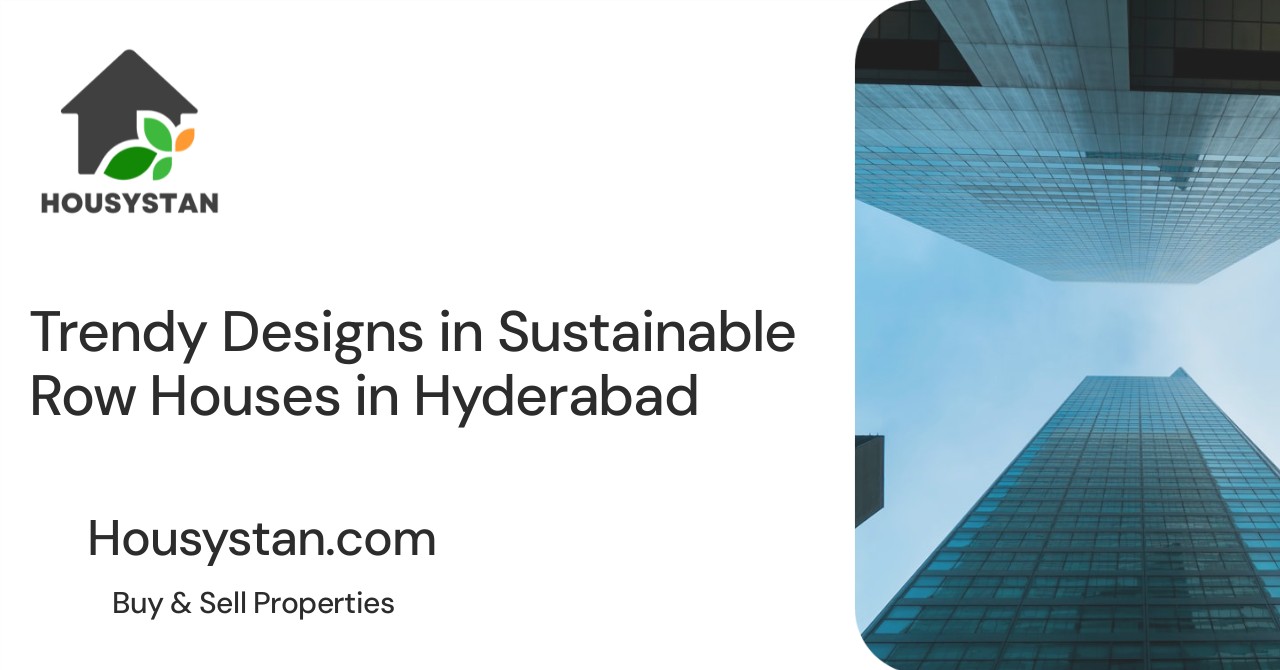Trendy Designs in Sustainable Row Houses in Hyderabad
Read latest blogs and articles from Housystan

The Information mentioned here was last updated on:
4/12/2025The Rise of Sustainable Row Houses in Hyderabad
Hyderabad, a bustling city known for its rapid growth and technological advancements, is witnessing a remarkable shift in housing trends. Among these, sustainable row houses are gaining significant attention. These eco-friendly homes not only cater to the growing demand for green living but also offer a trendy lifestyle choice for urban dwellers. Let's explore what makes these row houses both sustainable and stylish for modern Hyderabadis.
Understanding Row Houses
- Verified Tenants/Buyers
- Unlimited Property Listing
- Zero subscription/charges fee
Before diving into sustainability aspects, it's crucial to understand what row houses are. Row houses, also known as townhouses, are a series of identical or mirror-image houses sharing side walls. They are popular for their efficient use of space, providing individual living units while maintaining community connectivity. Their compact design is particularly suited for urban areas like Hyderabad, where space is at a premium.
Why Choose Sustainable Row Houses?
The increasing awareness of environmental issues and the need for sustainable living solutions have driven many in Hyderabad to opt for eco-friendly housing options. Sustainable row houses are designed with materials and technologies that minimize environmental impact, conserve resources, and reduce utility costs. Key features include energy-efficient appliances, solar panels, rainwater harvesting systems, and waste management solutions, making them an attractive choice for environmentally conscious buyers.
Innovative Design Elements
Sustainable row houses in Hyderabad are not only functional but also aesthetically appealing. Architects are embracing innovative design elements to create homes that are both beautiful and eco-friendly. Some of the notable design trends include:
1. Open Floor Plans: These homes often feature open floor plans that enhance natural lighting and ventilation, reducing reliance on artificial lighting and cooling systems. Large windows and skylights are common, allowing an abundance of natural light to flood in, creating bright and airy spaces.
2. Green Roofs and Walls: To combat urban heat and improve air quality, many row houses incorporate green roofs or vertical gardens. These not only add a touch of greenery but also act as natural insulation, keeping homes cooler and reducing energy consumption.
3. Sustainable Materials: Builders are increasingly using recycled and locally sourced materials in construction. Materials such as bamboo, reclaimed wood, and recycled steel not only reduce the carbon footprint but also lend a unique charm to the homes.
Energy Efficiency as a Priority
Energy efficiency is a cornerstone of sustainable row house design. These homes are equipped with modern technologies to reduce energy usage drastically compared to traditional homes. Here’s how they achieve this:
1. Solar Energy: Many row houses come with rooftop solar panels, converting sunlight into electricity. This not only reduces reliance on non-renewable energy sources but also significantly cuts down electricity bills.
2. LED Lighting: Energy-efficient LED lighting is standard in these homes. LEDs consume far less electricity and have a much longer lifespan than traditional bulbs, making them a sustainable choice.
3. Smart Home Technology: Integration of smart home technologies allows homeowners to monitor and control energy usage. From smart thermostats to automated lighting systems, residents can optimize energy consumption efficiently.
Water Conservation Techniques
Water scarcity is a pressing issue worldwide, and Hyderabad is no exception. Sustainable row houses incorporate several water-saving techniques:
1. Rainwater Harvesting: Many row houses come equipped with rainwater harvesting systems, capturing rainwater from rooftops and storing it for future use. This practice significantly reduces dependence on municipal water supplies.
2. Low-flow Fixtures: Installing low-flow taps and dual-flush toilets help reduce water consumption without compromising on functionality. These fixtures are a simple yet effective way to conserve water.
3. Greywater Recycling: Some row houses are designed with greywater recycling systems, which treat and reuse wastewater from sinks and showers for irrigation or toilet flushing, further optimizing water usage.
Community and Lifestyle
Sustainable row houses in Hyderabad are not just about individual homes; they promote a sense of community and shared values. These developments often feature shared spaces like gardens, playgrounds, and community centers, encouraging interaction among residents.
1. Community Gardens: Many row house communities include shared gardening spaces where residents can grow their own vegetables and herbs. This promotes local food production and reduces the carbon footprint associated with transporting food.
2. Eco-Friendly Transportation: Developers often prioritize eco-friendly transportation options. Bicycle racks and pedestrian-friendly pathways encourage residents to reduce reliance on cars, promoting healthier and cleaner living environments.
3. Educational Workshops: Some communities organize workshops and events focused on sustainability, educating residents on practices such as composting, waste segregation, and energy conservation.
The Future of Sustainable Living in Hyderabad
The trend towards sustainable row houses in Hyderabad is expected to continue growing as more people recognize the importance of eco-friendly living. Developers are likely to introduce even more innovative solutions to make these homes more resource-efficient. Additionally, government incentives for green construction could further propel the popularity of sustainable housing.
Ultimately, the rise of sustainable row houses represents a significant step forward in addressing the environmental challenges facing urban areas today. By combining modern design with eco-friendly practices, Hyderabad is setting an example for other cities aiming to balance growth with sustainability. As this trend continues, it could pave the way for a greener, more sustainable future in urban India.
Through this lens, we can see how sustainable row houses are transforming Hyderabad’s urban landscape and setting a new standard for modern, eco-conscious living.